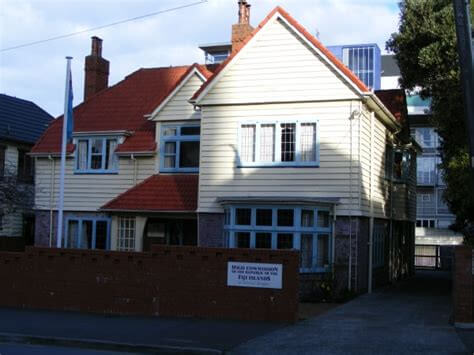FIJI
31 Pipitea Street, Thorndon, Wellington
In 1643, the Dutch explorer and navigator, Abel Tasman accidentally discovered Fiji in 1643. British Captain James Cook also sailed through the islands in 1774, but credit for the first significant European exploration goes to Captain William Bligh. The Republic of Fiji is a group of 331 beautiful islands and 520 islets, of which only about 100 are inhabited. The indigenous name for the islands is Viti meaning “east” or “sunrise”. The two main islands are Viti Levu and Vanua Levu which account for 87% of the population. The Capital is Suva situated on the south east of Viti Levu. Fiji has the most advanced economy of the Pacific islands, and is a renowned tourist destination.
The Chancery of the High Commission of Fiji is located at 31 Pipitea Street in Thorndon, Wellington. The building is a representative example of an early twentieth century Domestic Revival style house. The building is one of a group of older, single household residences on Pipitea Street that have survived the redevelopment of the area into a commercial office precinct. The building has a historic association with the Volunteer Service Abroad and was designed by William Gray Young, a significant Wellington architect in the 1920s.
The National Day of Fiji is celebrated on October 10th. Known as Fiji Day it is the anniversary of Fiji’s independence from British colonial rule in 1970. October Fiji was also ceded to the United Kingdom on 10th October 1874. The coat of arms of Fiji is the heraldic device consisting of a shield divided quarterly by Cross of St. George and charged with a gold lion at the top, supported by two Fijian warriors, one on each side, and topped with a canoe as the crest. The motto “Rerevaka na Kalou ka Doka na Tui” meaning “Fear God and honour the King” can be found inscribed at the bottom.
Fiji’s National flag flew for the first time on the day independence was declared in 1970. The flag features the Union Jack in the top left-hand corner and the shield from Fiji’s Coat of Arms on a light blue background. The Fijian shield is centred on the outer half of the flag; the shield depicts a lion holding a cocoa pod in its paws representing Fiji’s historical links with the United Kingdom. This is featured above a white field quartered by the cross of Saint George featuring stalks of sugarcane, a palm tree, bananas, and a white dove.

